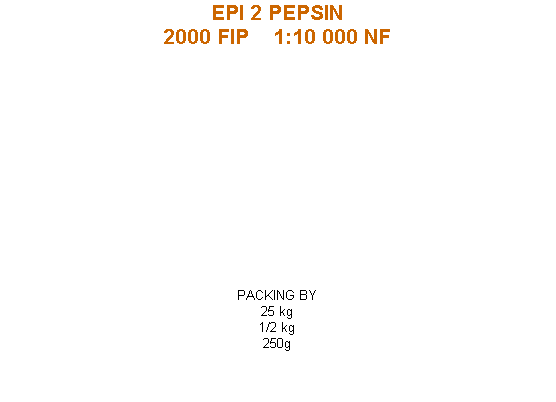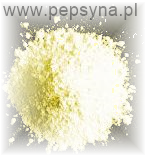

Rejestr w wykazie testów do diagnostyki in vitro GLW.xls

Data Sheet - Pepsin
Source:Porcine gastric mucosa
Systematic name:Peptidyl peptide hydrolase;
Other name Pepsin A
CAS - No.9001-75-6
E.C.- No.3.4.23.1
Occurrence
Acid proteinases are found in the gastric juice of mammals and have been reported in the juice of birds, amphibia and fishes. The major enzyme from the pig, pepsin A, is a single polypeptide of 327 residues and is formed by cleavage of 44 residues from the amino terminus of pepsinogen A; one or more of the peptide fragments removed inhibit the activity of pepsin A and other acid proteinases at pH values above 5. Besides having proteinase and peptidase activity, pepsin can catalyze the hydrolysis of suitable depsipeptids (ester analogues of peptides) and even of sulphite esters.
Characteristics
Composition: Pepsin has a law alpha-helical structure content. The protein configuration of the crystalline form is that of a compact nearly spherical molecule, the structure being maintained by hydrophobic bonds. The amino acid analysis shows a high content of aspartic acid, glutamic acid, and serine whereas the content of the basic amino acids is unusually low. This explains that pepsin even in 0.1 N HCl is still a negative ion.
Specificity: Almost all high molecular weight proteins are attacked by Pepsin; exceptions are keratins, mucins, ovomucoid, silk fibroin, spongin, protaminases and protein hydrolysis products of low molecular weight. Certain chemical substrates of low molecular weight are hydrolysed, particularly peptides containing in close proximity aromatic residues, tyrosine and cysteine, including for instance carbobenzoxy-L-glutamyl-L-tyrosine and L-histidine. The presence of two carboxyl groups is necessary for pepsin action on synthetic substrates. If both of the carboxyl groups are masked then pepsin will not split the resulting compound.
Effectors: Pepsin reacts more slowly than other proteinases on protein substrates and even more slowly on peptides. Generally, proteolysis by pepsin is greatly favoured if an aromatic ring is present in the side-chain of either of the amino acids on both sides of the bond hydrolyzed. The amino group may involve a tyrosine or a phenylalanine residue. When both involved residues are aromatic, these are split even more rapidly than any others.
Catalytic optima: The optimum pH of activity on proteins is between 1.6 and 1.8 and is narrower for crystalline pepsin than for a crude preparation.
Below pH 5, the conversion of pepsinogen is effected by pepsin in an autocatalytic process that involves the removal of the 41-residue amino terminal portion of the zymogene. Several low molecular weight products are formed, including an inhibitory peptide composed of 29 amino acid residues. This inhibitor, which was obtained in crystalline form, is bound to pepsin at pH 5; at more acid pH values, dissociation of the pepsin-inhibitor complex is favoured, and the peptide is cleaved. The rate of activation is optimal at pH 2, is first-order with respect to both pepsinogen and pepsin, and is increased by the addition of inorganic salts.
Stability of solution: Pepsin is in aqueous solution at pH 5-5.5 relative stable. The stability is higher in Glycerine. Pepsin is irreversible inactivated in alkaline medium.
Solubility: freely soluble in water, insoluble in most organic solvents.
Molecular weight: 34500 Daltons. (4)
Isoelectric point: pH 1.0 (3)
Isoionic point: 2.2-3.0 (3)
Spectral data: E280 (1%, 1cm) = 14.7 (3)
Assay
The method described here is the one given by Lauwers and Scharpé (5) and by current European Pharmacopoeia.
Principle
The activity of pepsin powder is determined by comparing the quantity of peptides nonprecipitable by trichloroacetic acid solution R and assayed using the Folin-Ciocalteus-Phenol-Reagent which is released per minute from a substrate of haemoglobin solution R with quantity of such peptides released by pepsin reference standard BRP from the same substrate in the same conditions. The blue colour developed due to tyrosine and tryptophan is measured colorimetrically,
Unit definition
1 FIP unit (≈ Ph. Eur. unit) of Pepsin activity is contained in that amount of standard preparation, which upon incubation at 25.0 ± 0.1 °C for one minute with a suitable preparation of pure haemoglobin will cause the decomposition of the haemoglobin to such an extent that the amount of hydroxyaryl substances liberated will, upon reaction with Folin-Ciocalteus-Phenol-Reagent, result in the formation of a coloured solution of equal intensity to that, resulting from the reaction of 1 micromole of tyrosine with the reagent.
Reagents
Hydrochloric acid, dilute R2: Dilute 30 ml of 1 N HCl to 1000 ml with distilled water; adjust to pH 1.6 ± 0.1.
Thiomersal (C9H9HgNaO2S, Mr = 404.8 g/mol): Merck, Order-N° 8.17043.
Haemoglobin solution: Transfer 2 g of haemoglobin R to a 250 ml beaker and add 75 ml of A. Stir until solution is complete. Adjust to pH 1.6 ± 0,1 using 1 N HCl. Transfer to a 100 ml flask with the aid of A. Add 25 mg of B. Prepare daily, store at 5 ± 0.1 °C and readjust to pH 1.6 before use.
Folin-Ciocalteus-Phenol reagent: Merck; Order-N° 1.09001
Trichloroacetic acid solution (5%): Dissolve 50.0 g trichloroacetic acid R (C2HCl3O2; Mr = 163.4 g/mol) in distilled water and dilute to 1000 ml with the same solvent
Sodium hydroxide Solution (20%): Dissolve 20.0 g of NaOH in distilled water and dilute to 100 ml with the same solvent.
Enzyme solution: Immediately before use, prepare a solution of pepsin Reference Standard BRP and of the substance to be examined expected to contain 0.5 Ph. Eur. U.per millilitre in A; before dilution to volume, adjust to pH 1.6 ± 0.1, if necessary , using 1 N HCl.
Filter paper control: Determine the suitability of the filter paper by filtering through the paper 5 ml of protein precipitation reagent. Measured at 275 nm against an unfiltered aliquot of the reagent the absorbance of the filtered reagent should not exceed 0.04.
Pepsin Reference Standard is issued by: Centre for Standards FIP, Harelbekestraat 72, B-9000 Ghent, Belgium. Or European Pharmacopoeia, Council of Europe; BP 907; 67029 Strasbourg Cedex 1 (France)
Procedure
Place flasks of C and E in the water bath to equilibrate at 25 ± 0.1 °C
Label S1 BS1 S2 BS2 S3 BS3 T BT B
ml A 0.5 0.5 0.25 0.25 ---- ---- 0.25 0.25 1.0
ml standard 0.5 0.5 0.75 0.75 1.0 1.0 ---- ---- ----
ml sample ---- ---- ---- ---- --- --- 0.75 0.75 ---
ml 5% TCA E --- 10.0 --- 10.0 --- 10.0 --- 10.0 10.0
Mix X X X X X X X X X
Equilibrate to 25 °C in a water bath 5 Minutes X X X X X X X X X
ml Haemoglobin C 25 °C 5.0 5.0 5.0 5.0 5.0 5.0 5.0 5.0 5.0
Mix and incubate at 25 °C in a water bath for exactly 10 min X --- X --- X --- X --- ---
ml 5% TCA E 10.0 --- 10.0 --- 10.0 --- 10.0 --- ---
Mix X X X X X X X X X
Remove from water bath after 30 minutes and allow standing at room temperature for 20 min, centrifuge or filtering twice through the same suitable filter paper to remove any insoluble material remaining.
In other tubes with the same name give from the clear solutions 3 3 3 3 3 3 3 3 3
distilled water 20 20 20 20 20 20 20 20 20
+ml NaOH-Solution F 1 1 1 1 1 1 1 1 1
+ ml D 1 1 1 1 1 1 1 1 1
After 15 minutes measure the absorbance of solutions at 540 nm in 1 cm cells using the solution of Blank (B) as the compensation liquid.
Calculation
Correct the average absorbance values for the filtrates obtained from tubes S1, S2, S3 by subtracting the average values obtained for the filtrates from tubes BS1, BS2, BS3 respectively.
Draw a calibration curve of the corrected values against volume of reference solution used. Determine the activity of the substance to be examined using the corrected absorbance for the test solution (T-BT) together with the calibration curve and taking into account the dilution factors.
Other assays (1, 6)
Anson: The rate of hydrolysis of denatured haemoglobin by pepsin is measured by the increase in absorption at 280 nm. A unit is the enzyme activity, which causes an increase in absorption of 0.001 per min. under the condition of the assay. (37 °C, 10 minutes)
NF XII: Pepsin, when assayed under standard condition digests not less than 3000 and not more than 3500 times its weight of coagulated egg albumen.
BP: Pepsin, when assayed under standard condition digests 2500 times its weight of coagulated egg albumen.
Availability
Standard qualities
Pepsin 1:10000 NF
Pepsin Ph. Eur.
Customized qualities are available upon request.
References
Bergmeyer, Methods of enzymatic analysis; third edition, volume V; Verlag Chemie; Weinheim Deerfield, Florida Basel, 1974.
Ruyssen, R.; Lauwers, A.: Pharmaceutical Enzymes, Properties and assay methods, Story-Scientia, Gent 1978
Enzymes and related biochemicals; Biochemical products devision; Worthington Diagnostic systems, inc.; Freehold, New Jersey 07728 U.S.A.; Printed 1982.
Pharmaceutical Substances; 13th edition; P-Pk; ABDATA Pharma-Daten Service; Eschborn/Taunus; 2003.
Lauwers, A.; Scharpé, S.: Pharmaceutical Enzymes, drugs and pharmaceutical sciences., Volume 84, Marcel Dekker, Inc., New York-Basel-Hong Kong, 1997.
Stellmach, B.: Bestimmungsmethoden Enzyme für Pharmazie, Lebensmittel-chemie, Technik, Biochemie, Biologie, Medizin. Steinkopff-Verlag, Darmstadt, 1988.



